Baked meatballs — Bulgarian style
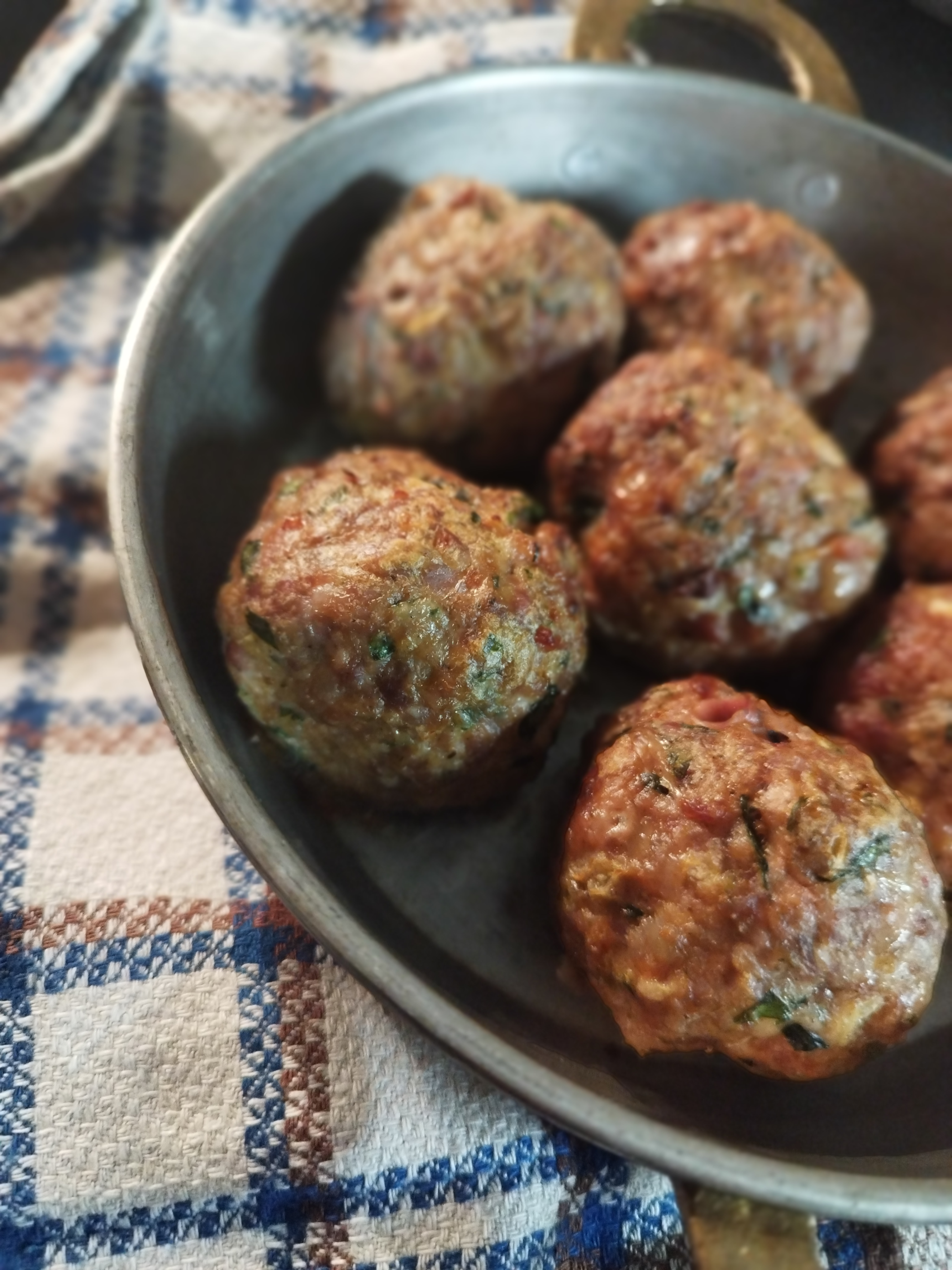
Baked meatballs is ground meat tossed together with herbs and spices, then baked in the over at high temperature until golden brown and perfectly cooked. There is a myriad of ways you can make them, but the combination of those spices and herbs, along with the bread and breadcrumbs, give the meatballs the perfect moisture and tenderness.
Depending on your tastes you can also change or add additional ingredients such as the meat (lamb instead of pork) red/green bell peppers (brilliant taste), herbs and spices. For example Bulgarian meatballs calls for use of red paprika, summer savory and cumin while, Greek meatballs are generally made with mint and oregano, parsley, garlic, onion and lime zest, Italian meatballs include spices and herbs such as basil, oregano, parsley, garlic, and Parmigiano Reggiano cheese, while the Turkish meatballs typically use cumin, coriander, smoked paprika, parsley, garlic, and onion. In this recipe I will you show you how to do traditional Bulgarian meatballs
Each ingredients added will and can significantly change the overall flavour, texture and tenderness.
- Ground meat – For this I used 60% pork and 40% beef, but you can use any proportion you like.
- Eggs – Large eggs at room temperature work excellently.
- Onion – Yellow, red, white, or shallot can be used.
- Garlic– Regular old cloves are used (check your garlic strength before adding- it can be too strong).
- Herbs – Fresh parsley is used.
- Spices– For this recipe I will use red paprika, summer Savory and cumin.
- Breadcrumbs – Regular breadcrumbs.
- Bread — Any bread is suitable; in this case I used wholegrain.
- Seasoning – Salt and freshly ground peppercorns are used to season to taste. Note- ask you butcher about salt present in the ground meat, it can be pre added.
- Oil – Most meatballs recipes will ask for oil, in my humble opinion it’s not needed. The meatballs will let a little bit of its own fat while cooking.

Step-by-step recipe for Baked Meatballs
- Start by gathering your ingredients.
- Remove the crust of the dried bread, so that only the white part will be left. You can use the remaining crust for making homemade breadcrumbs
- Add the ground meat, the eggs, the diced onion and garlic, the breadcrumbs, the white part of the bread, some salt and pepper to a mixing bowl and start mixing everything to combine. Don’t over do it.
- Let it rest for at least 1h, preferably 24h in the refrigerator
- With the help of your hand and a little bit of water shape 20 round-like meatball and place them on a tray with a parchment paper.
- Bake them on the middle of your oven with fan on @ 220°C (430° F) for 20-25 min.
- Check them on the 20 min mark with a food thermometer and aim for 69-70°C (156–158°F.). Let them rest for 5 min (they will continue cooking to the internal temperature of 72-73°C (162–163°F) and serve.
- Note- Those temperatures are for mixed (pork and beef) ground meat. Adjust the temperature according to the type of meat that you are using.
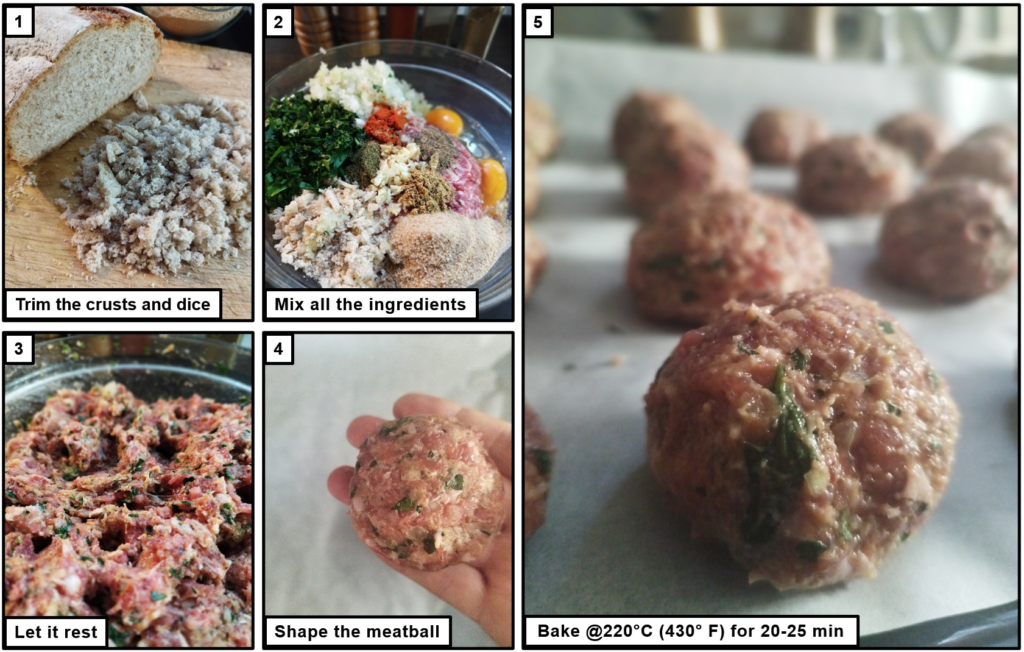
The science behind juice baked meatballs
1. Choose your meat wisely
For the Bulgarian baked meatball we tend to use ground meat from pork and beef in 60:40 or 50:50 (pork: beef) proportions. Beef tends to give flavour and structure while pork adds softness and moisture. Fat is the key component to flavourful and tender meatball. The ideal fat content for pork: beef mixes is 20–30%. If fat is too low, the meatball becomes dry and sandy and if it’s too high it can leak from the meatballs during the cooking and they can collapse. Remember that the fat adds flavour and moisture so don’t skip it.
| Ratio (Beef:Pork) | Texture | Juiciness | Notes |
| 100% Beef | Firm, slightly dry | Moderate | Use higher-fat beef (80/20) or add panade to avoid toughness. |
| 75% Beef / 25% Pork | Balanced but dense | Slightly juicy | Good if you want structure and bite. |
| 50% Beef / 50% Pork | Tender and cohesive | Juicy | Classic ratio — excellent balance of taste and texture. |
| 40% Beef / 60% Pork | Softer, lighter | Very juicy | Great for baked meatballs or when adding cheese/herbs. |
| 100% Pork | Very soft | Very juicy | May lack structure — can get mushy if overmixed or overbaked. |
2. DON’T overmix your meatball mix
Myosin is a motor protein involved in the muscle contraction. In the context of meatballs, myosin is important for (2,3):
- Binding: myosin helps protein-protein binding holding the meat together
- Gel formation: in the presence of heat it can form gels (semi-solid substance made primarily of water) which will be an important factor for the juiciness and firmness.
- If you overdo: You squeeze the water that myosin was bound to which will evaporate during baking. This will lead to dry and rubbery in texture.
3. Add salt
By adding salt to your meat mixture, it will not only add seasoning but also has a pivotal role in solubilizing myosin, which will improve the efficacy of myosin to bind to other protein and water (1,2).
By adding salt, you will:
- Makes the gels more stable
- Increase the retention of water
- Result in juicier and more tender end product
4. Eggs, panade or both.
Eggs are made primary of proteins and fat. By adding eggs to the mixture, you will (4):
- When heat is applied the proteins in the eggs will coagulate, which can act as a glue, bringing the meat together.
- Adds a slight but rich flavour.
- Recommended use 1 medium size egg per 500g ground meat
Panade from the other hand is bread soaked in water or milk and then drained. Why it works:
- Bread is made from grains containing starch, when soaked that starch granules will swell, acting as a sponge, holding the water in the meatballs while cooking.
- The result will be juicier and more tender meatballs
- Recommended use is 1 loaf of bread without the crust with 2-3 tbsp of water/milk.
Many recipes will use both, or they will use it separately. You can experiment with it and try for yourself. In this case I used only breadcrumbs and old dry bread because the eggs will serve as my primary binder through protein coagulation, while dry breadcrumbs and bread will function as structural fillers. Although no external water or milk was added, the dry components absorb juices released during cooking, moderating myosin network contraction and contributing to a cohesive yet tender meatball texture.
| Feature | Eggs | Panade |
| Binding | Protein coagulation | Physical sponge + starch |
| Moisture retention | Moderate | High |
| Texture | Denser, firmer | Soft, tender, spongy |
| Flavor | Adds richness | Neutral (water) Slightly rich (milk) |
5. Temperature:
The internal temperature of the meatball will affect the structure, tenderness and flavour
- Aim for an internal temperature of 69-70°C (156–158°F.) before resting and 71-73°C (162–163°F) after resting. That’s hot enough to be food safe but not hot enough for protein denaturation and excessive water evaporation.
- Don’t exceed and internal temperature of 80°C – extensive denaturation of proteins (myosin, actin, albumin from the egg) leading to denser texture and rubbery structure. Also high heat = more evaporation of water to evaporate = bad end product.
I hope that next time you shape meatballs, you remember that behind their juiciness lies real science.
Baked Meatballs— Bulgarian style
Ingredients
Method
- Start by gathering your ingredients.
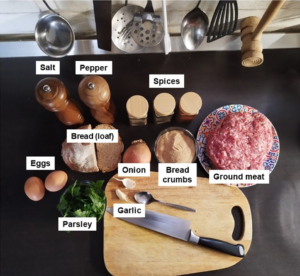
- Remove the crust of the dried bread, so that only the white part will be left.
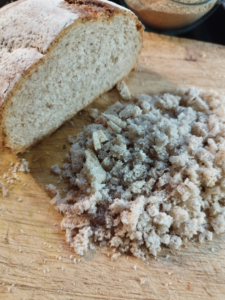
- Add the ground meat, the eggs, the diced onion and garlic, the breadcrumbs, the white part of the bread, some salt and pepper to a mixing bowl and start mixing everything to combine.
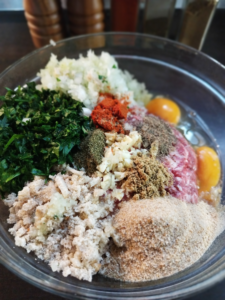
- Let it rest for at least 1h, preferably 24h in the refrigerator.
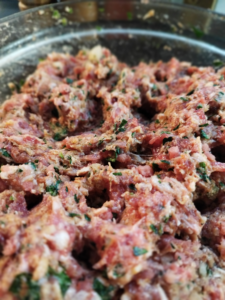
- Shape 20 meatball and place them on a tray with a parchment paper.

- Bake them on the middle of your oven with fan on @ 220°C (430° F) for 20-25 min.

- Check them on the 20 min mark with a food thermometer and aim for 69-70°C (156–158°F.)
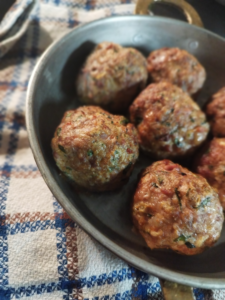
- Let them rest for 5 min (they will continue cooking to the internal temperature of 72-73°C (162–163°F) and serve.
References:
1. Offer, G. & Trinick, J. (1983). On the mechanism of water holding in meat: The swelling and shrinking of myofibrils. Meat Science, 8(4), 245-281. doi:10.1016/0309-1740(83)90013-X
2. Asghar, A., Samejima, K., & Yasui, T. “Functionality of muscle proteins in gelation mechanisms of structured meat products.” Critical Reviews in Food Science & Nutrition, 22(1), 27-106
3. Tornberg, E. (2005). “Effects of heat on meat proteins – Implications on structure and quality of meat products.” Meat Science, 70(3), 493–508.
4. Mine, Y. (1995). “Recent advances in the understanding of egg white protein functionality.” Trends in Food Science & Technology, 6(7), 225–232.
